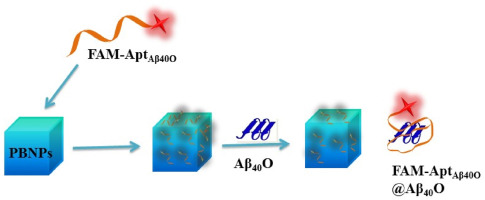Talanta ( IF 5.6 ) Pub Date : 2020-03-19 , DOI: 10.1016/j.talanta.2020.120930 Wenlan Chen 1 , Ge Gao 2 , Yan Jin 2 , Chunyan Deng 1

|
Amyloid β peptide oligomeFrs (AβOs) have been proved to be crucial biomarkers of Alzheimer's disease (AD). To explore an applicable method for the determination of AβOs is significant for the early AD diagnosis. Prussian blue nanoparticles (PBNPs), as one excellent nanomaterials, have the advantages of good stability, favorable biocompatibility, low cost, easy preparation and controllable shape. PBNPs was found to be of the fluorescence quenching ability to fluorophores, and the adsorption of DNA onto PBNPs surface occurred via the binding of phosphate skeleton in DNA to Fe2+/Fe3+ in PBNPs. On basis of this, carboxyl fluorescein (FAM) modified Aβ40O-targeting aptamer (FAM-AptAβ) was adsorbed onto PBNPs. And FAM-AptAβ@PBNPs-based fluorescent aptasensor for the determination of Aβ40O was developed. Upon incubating FAM-AptAβ@PBNPs with Aβ40O, the fluorescence intensity of the FAM-AptAβ@PBNPs obviously increased comparing to the initial fluorescence intensity of the FAM-AptAβ@PBNPs. The changes in the fluorescence intensity of the FAM-AptAβ@PBNPs were linear with the Aβ40O concentrations ranging from 1.00 nM to 100 nM. Moreover, AD patients and healthy persons can be distinguished using this method to determine Aβ40O concentrations in human cerebrospinal fluid samples from AD patients and healthy persons. It demonstrates that this PBNPs-based aptasensor is not only simple and cost-effective, but also sensitive, selective and more applicable. This fluorescent sensing strategy is promising for the development of aptasensor in clinical fields.
中文翻译:

一种基于普鲁士蓝纳米颗粒的荧光猝灭的Aβ40O生物传感器。
淀粉样蛋白β肽寡聚体(AβOs)已被证明是阿尔茨海默氏病(AD)的关键生物标志物。探索适用的AβOs测定方法对AD的早期诊断具有重要意义。普鲁士蓝纳米颗粒(PBNPs)作为一种优良的纳米材料,具有稳定性好,生物相容性好,成本低,易于制备,形状可控的优点。发现PBNP具有对荧光团的荧光猝灭能力,并且DNA在PBNP表面上的吸附是通过DNA中的磷酸盐骨架与PBNP中的Fe 2+ / Fe 3+的结合而发生的。上的此基础上,羧基荧光素(FAM)改性Aβ 40 O型靶向适体(FAM-公寓Aβ)吸附到PBNPs。和FAM-公寓Aβ针对Aβ的决心@ PBNPs系荧光适体传感器40 O的发展。一旦孵育FAM-公寓Aβ与Aβ@PBNPs 40 O时,FAM-公寓的荧光强度Aβ @PBNPs明显增加比较到FAM-公寓的初始荧光强度Aβ @PBNPs。在FAM-公寓的荧光强度的变化Aβ @PBNPs是线性的与Aβ 40个ø浓度范围从1.00至100nM。此外,使用此方法可以确定AD患者和健康人的Aβ40来自AD患者和健康人的人脑脊液样本中的O浓度。它证明了这种基于PBNPs的适体传感器不仅简单且具有成本效益,而且灵敏,选择性强并且更适用。这种荧光传感策略对于在临床领域开发适体传感器是有前途的。











































 京公网安备 11010802027423号
京公网安备 11010802027423号